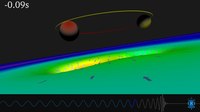
Photo from wikipedia
Gravitational waves from binary neutron star post-merger remnants have the potential to uncover the physics of the hot nuclear equation of state. These gravitational-wave signals are high frequency (∼ kHz) and… Click to show full abstract
Gravitational waves from binary neutron star post-merger remnants have the potential to uncover the physics of the hot nuclear equation of state. These gravitational-wave signals are high frequency (∼ kHz) and short lived ($\mathcal {O}(10\, \mathrm{ms})$), which introduces potential problems for data-analysis algorithms due to the presence of non-stationary and non-Gaussian noise artefacts in gravitational-wave observatories. We quantify the degree to which these noise features in LIGO data may affect our confidence in identifying post-merger gravitational-wave signals. We show that the combination of vetoing data with non-stationary glitches and the application of the Allen χ2 veto (usually reserved for long-lived lower-frequency gravitational-wave signals), allows one to confidently detect post-merger signals with signal-to-noise ratio ρ ≳ 8. We discuss the need to incorporate the data-quality checks and vetos into realistic post-merger gravitational-wave searches, and describe their relevance to calculating realistic false-alarm and false-dismissal rates.
Journal Title: Monthly Notices of the Royal Astronomical Society
Year Published: 2023
Link to full text (if available)
Share on Social Media: Sign Up to like & get
recommendations!